Case
Study Research Methods (Observation)
Jeong-Hwan Choi
Department of Human Resource Education,
Graduate School of Education, University of Illinois at Urbana-Champaign, 351
Education Building, 1310 South Sixth Street, Champaign, IL 61820.
Email: jchoi52@illinois.edu.
Background
I'm
taking the Case Study Methodology Course (EPSY490) at
My questions were:
1.
How
many minorities participated in the Festival?
2.
Are
there any behavioral differences among minority families?
3.
Who
does take care of children in minority families?
Furthermore, the applied framework was
composed four categories:
1.
Family
setting
2.
Shopping
items at the festival
3.
Pattern
of moving
4.
Child
caring patterns
By using these questions and framework, I
started my observation of minority families.
Observation Method

The observation place was selected for high accessibility for participating families to main ticket booth and events. The observation time was since the period was initiating time of holding opening ceremony and main events.
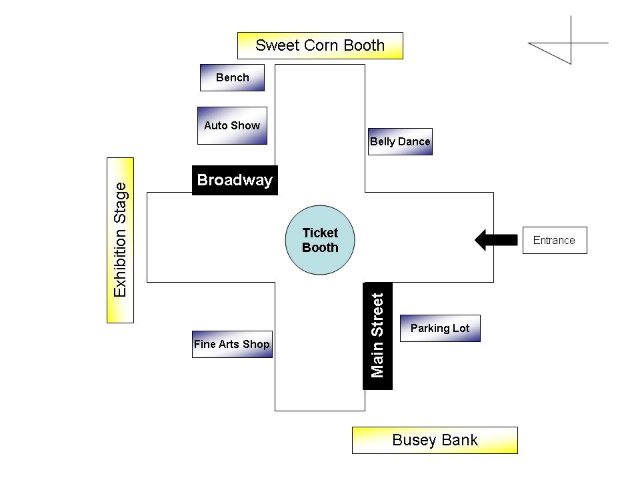
Observation1. Ethnical Compositions at Sweet Corn Festival.
To identify the ethnical
compositions at Sweet Corn Festival, I counted the number of buyers during
According to

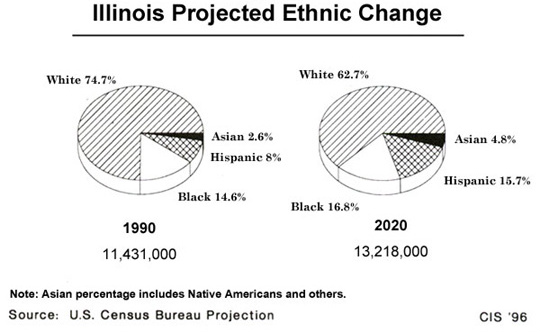
The result of population observation
at Sweet Corn festival 2008 was quite similar to the census of
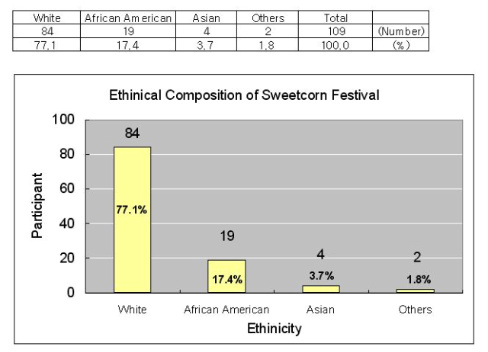
The short observation of Sweetcorn festival 2008 ethnic composition is quite similar to the results of census on 1990 except the Hispanic.
The result could be caused from my limitation to identify hispanics from white people but still the population of hispanics who joined participated the Sweetcorn Festival is still few comparing withe the census of Illinois state.
Meanwhile, I tried applying simple frameworks as to identify question 2, 3.
1. Family setting
2. What they consumes at the festival?
3. Pattern of moving
4. Child caring pattern
Observation 2. Settings of Minority Family
Five cases were observed under the suggested frameworks.
Case1: Asian family (Thai)
- Family setting: Grad father(60s), Grand mother(60s), Father(30s), Boy (6~7 yrs), Girl (4~5 yrs)
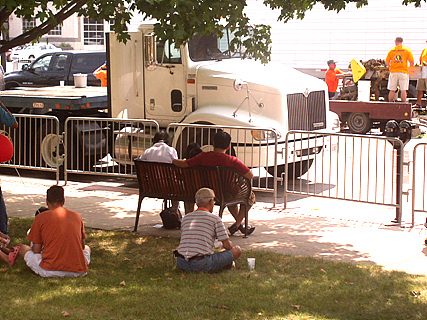
Case2: Combined Family (African American Father & Hispanic Mother)
- Family setting: Father (40~50s), Mother (30s), Boy (2~3 yrs)
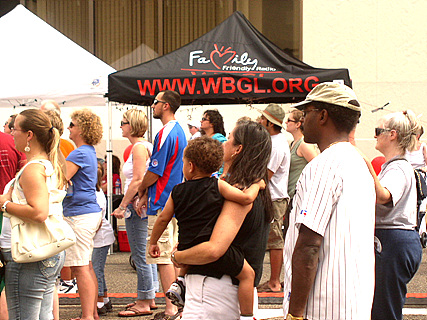
Case3: Indian Family
- Family setting: Father (30s), Mother (20~30s), Boy (2~3 yrs)
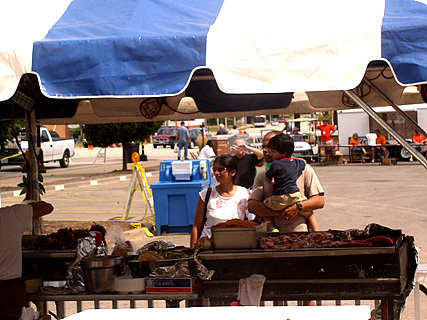
Case4: African American Family
- Family setting: Father (20~30s), Mother (20~30s), Boy (6~7 yrs), Girl (3~4 yrs)

Case5: Korean Family
- Family setting: Father (30s), Mother (30s), Girl (8~9 yrs), Boy (5~6 yrs), Boy (1~2 yrs)
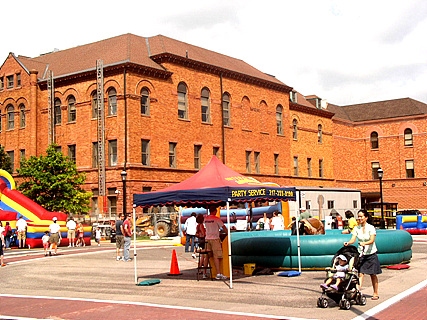
Observation3. Limited route &
shopping.
Although many white families
actively joined many events or enjoyed various shopping opportunities, minority
families showed limited moving patterns and shopping activities.
Case 1, 4, 5 had been very similar
moving patterns. They came from entrance and move to the sweet corn booth and
bought some sweet corns, then enjoyed them near to the booth. After looking
around events booth at the main street, they came back to the entrance or
parking lot.
Case 2 family participated in the
Taekwondo exhibition and moved to Sweet Corn booth and booth some sweet corns.
The father communicated with News Gazette Sales person for some time, however
the mother and kid kept a distance and looked on them. The moving
directions were usually led by the woman.
Case 3 showed the most active
moving among minority families. The father led whole directions and movements.
They, firstly, visited the Greek Food booth located in the left hand side of the
Main street and but did not buy anything. They moved the Sweet Corn booth direction
and visited another Greek Food booth, but did not buy anything either. However,
when they headed to the Busey Bank direction, they dropped by the Mirabelle Fine
Arts Gallery and bought a bunch of items. After enjoying shopping at the fine
art shop, they moved to the ticket booth and stood on the line in front of Thai
Food Booth. At there, they met another Indian family and communicated for a
long time.
In sum, minority families
bought only sweet corns and some snacks or beverage, except the case 3.
Observation4. Different Interaction Patterns in Minority Families (Child Caring
Patterns)
Minority families showed
different interaction patterns for caring their children.
In Case1 (Thai family), Men
(Grandfather, Father) had a strong interaction to the boy. However, the girl
was taken care of by grandmother only. For instance, grandfather communicated
with father and boy with keeping eye contact, but grandmother and the girl did
not much involve in conversation when they enjoyed a cup of Cold stone ice
cream at a parking lot bench. Another event also showed the gender specific
relationship. When they ate sweet corns, sitting on a bench near to the sales
desk of sweet corns, father sat besides the boy and grandmother sat just behind
of the girl. The grandfather, however, sat apart from other families with
communicating with father.
Case 2 (African American
Father, Hispanic mother) showed a strong relationship with mother and the body,
on the contrary to the case 1. The mother always cared her boy and carried him
any places, however, the father did not much involved the interaction between
them. When the family went through the News Gazette booth, the father had five
minutes chat with advertiser. But the mother and the boy stepped back a few
feet and waited the father.
Indian family (Case 3) was
quite different from case 2. The father carried his boy all the time, but the
mother was looked a little bit separated. However, when the boy cried, the
mother abruptly took him and calm down him.
African American family (Case
4) showed quite equal interactions with their children. The father and mother
exchanged their position to take care of her children. There seemed no
specifically strong or weak relationship with according to gender.
Case 5 (Korean family), on the
contrary to the case 4, they showed gender specific roles and interactions.
The mother took care of all
three kids, but the father only communicated with the mother with stepping back
a feet.
Summary
The portion of Minority
families at Sweet Corn festival was smaller than the state census results.
They spent and enjoyed less than the
white families and showed a different style of interaction patterns, which may
from cultural differences of gender roles.
Discussions
1.
Why
minorities did not come to the festival?
2.
Why
minority families did not enjoy the festival as much as the white ones?
3.
Which
cultural differences made the different behaviors in child caring?
Reference
Bouvier & Jenkins, Shaping Illinois: The
Effects of Immigration, 1970-2020, Center Report, http://www.cis.org/articles/1996/illinois.html
, March 1996.
'Story telling' 카테고리의 다른 글
| 에니어 그램 성격 유형 테스트 결과 (0) | 2009.12.30 |
|---|---|
| Breathe in the center of the U.S. (미국의 중심에서 숨쉬다) (2) | 2009.07.08 |
| Unison Chalice Lighting (촛불을 켜면서...) (0) | 2008.10.06 |
| 창의적 아이디어를 위한 마인드맵 소프트웨어 (ManDKi) (3) | 2008.07.25 |
| (혼인서약) 최정환.김기선미 (0) | 2008.07.21 |



댓글